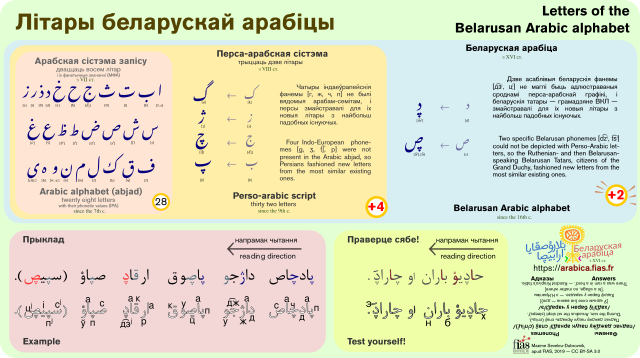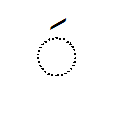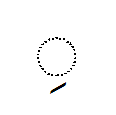Top Qs
Timeline
Chat
Perspective
Belarusian Arabic alphabet
Arabic-based alphabet for Belarusian From Wikipedia, the free encyclopedia
Remove ads
The Belarusian Arabic alphabet[a] or the Belarusian Arabica[b][1] was based on the Perso-Arabic script and was developed in the 15th or 16th century. It consisted of 28 graphemes, including several additions to represent Belarusian phonemes not found in the Arabic language.


The Belarusian Arabic alphabet was used by the Lipka Tatars, who had been invited to settle in the eastern territories of the Grand Duchy of Lithuania—a region that now comprises modern-day Belarus. During the 14th–16th centuries they gradually stopped using their own language and started using the Ruthenian language (modern Belarusian and Ukrainian) rendered in the Belarusian Arabic alphabet. Books of that literary tradition are known in Belarusian as Kitab (Belarusian: Кітаб), which is Arabic for 'book' or 'written material'.

Some Polish texts were also written in the Arabic script in the 17th century or later.[2]
Remove ads
Additional graphemes
- For the sounds /ʒ/ (ж), /t͡ʃ/ (ч) and /p/ (п), which are absent from the Arabic language, the following Persian graphemes were used:
- For denoting the soft /d͡zʲ/ (дзь) and /t͡s/ (ц) sounds, the following newly constructed graphemes were used:
- These graphemes were used during the 16th–20th centuries to write Belarusian and Polish.[2]
- و
Remove ads
Equivalence chart
Summarize
Perspective
Vowels
- Vowels A and E (initial اَ)
- Vowels I and Y (initial اِ)
- Vowels U and O (initial اُ)
- No vowel
- Consonant gemination
/a/ is consistently written long (that is, with a mater lectionis), while /e/ is consistently written short.
/o/ is most commonly written long.[3]
Consonants
Ligature
Sample text
Below is a sample text, Article 1 of the Universal Declaration of Human Rights.[4]
Remove ads
See also
- Belarusian Latin alphabet
- Arebica – modified Arabic script used for Serbo-Croatian
Notes
- Belarusian: Беларускі арабскі алфавіт / بلاروسكى آرابسكى آلفاوىط, romanized: Biełaruski arabski ałfavit
References
Further reading
External links
Wikiwand - on
Seamless Wikipedia browsing. On steroids.
Remove ads





